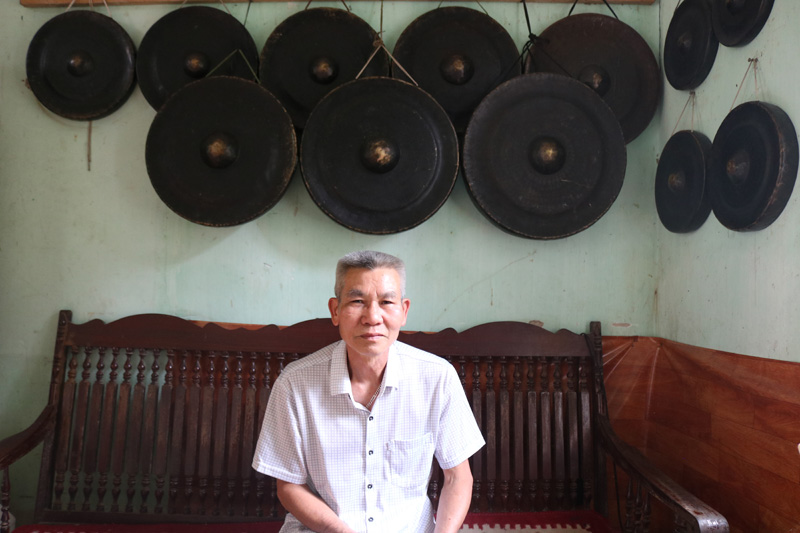
(HBO) - For many generations, gong has become an indispensable part of the spiritual life of the Muong ethnic group. Being one of the few people living in Hoa Binh City, who owns the Muong ethnic gongs, Mr. Dinh Van Nien (Moi Mit village - Yen Mong commune) always respects and preserves the precious gong set of his family.

The Muong ethnic gong set - the pride of Mr.
Dinh Van Nien is always being placed in the most prominent position and most
visible in the house.
Although being passionate about gongs since
he was very small but in 1994, when he became a cultural officer of Yen Mong
commune, Mr. Nien was able to collect and buy Muong ethnic gongs. On his
working days in the commune, he began to save a part of his salary to buy
gongs. Having done continuously in 15 years, in 2009, his gong set was full of
12 pieces.
Previously, he loved to play and watch
playing gongs. He did not have one at his home, so he had to borrow from the
women in the village. Every time there is a need, he had to go around the village
to borrow a few gongs for playing. Borrowing for a long time made him so
embarrassed; he bravely bought the gongs for his own. At that time, his commune
staff salary was only about 500,000 VND / month. He had to feed the family,
support for the children’s study,he had to save every change to have enough
money to buy each gong. Most of these gongs were bought from Thanh Hoa, Ha Nam
and some other places. A set of gongs can have 7 or 9 pieces but the standard
set of Muong ethnic group must be 12 pieces resembling for 12 months of the
year. Each gong carries a different sound. Despite difficulties, he still tried
to buy a set of 12 pieces because "12 months to make a new year, 12
different sounds to create a piece of Muong ethnic music."
Since his family had gongs, at festivals or
cultural exchanges events, he has lent them to the women in the local. Mr. Nien
said: "In 2015, Yen Mong commune received the title of the new rural
standardized commune. His gong set, together with gongs from other households were
up to 50 gongs, were performed by the art team at the ceremony. Especially, on
the occasion of the 55th Anniversary of Uncle Ho's visit to the Hoa Binh Youth
Vocational School, the gong team of the commune was honored to contribute
special performance, contributing to the opening ceremony of the Relics Area
more exciting and deep of ethnic culture. The gong has been displayed in his
house for many years and he considers it as a member of the family, an integral
part of his life."
Hoa Binh province has carried out multiple programmes and initiatives to revive its cultural heritage which has gradually fallen into oblivion through the ebbs and flows of history.
The most prominent and defining feature in the prehistoric era of Hoa Binh is the Hoa Binh Culture. The Culture was first discovered in Hoa Binh. The significant prehistoric culture represents not only Vietnam but also Southeast Asia and southern China. Through excavations of cave sites in the limestone regions of Hoa Binh, French archaeologist M. Colani introduced the world to a "Stone Age in Hoa Binh province – Northern Vietnam" in 1927. On January 30, 1932, the First Congress of Far Eastern Prehistorians, held in Hanoi, officially recognised the Hoa Binh Culture.
Known as the "Land of Epic History”, Hoa Binh province, the gateway to Vietnam’s northwest, boasts a strategic location and a unique cultural tapestry woven by its ethnic minority communities.
The People's Committee of Luong Son District recently held a ceremony to receive the certificate recognizing Sau Communal House in Thanh Cao Commune as a provincial-level historical and cultural site.
Recognising the importance of cultural heritage preservation in protecting and promoting the value system of Vietnamese culture, and serving socio-economic development in the new period, Party committees and local administrations in Hoa Binh province have identified it as a key task in the cultural development strategy. The province has been making efforts in mobilising resources, creating consensus among people and engaging ethnic communities in preserving and promoting cultural identity.
Hoa Binh province has captured growing attention both domestically and internationally for its distinctive cultural heritage and rich history. Most notably, it has been renowned for its famous Hoa Binh culture, considered the cradle of ancient Vietnamese civilisation. Looking ahead to significant milestones in 2025 and the 140th anniversary of province establishment in 2026, Hoa Binh Newspaper presents a comprehensive overview of the province's development across economic, social, cultural, tourism, and security domains.



